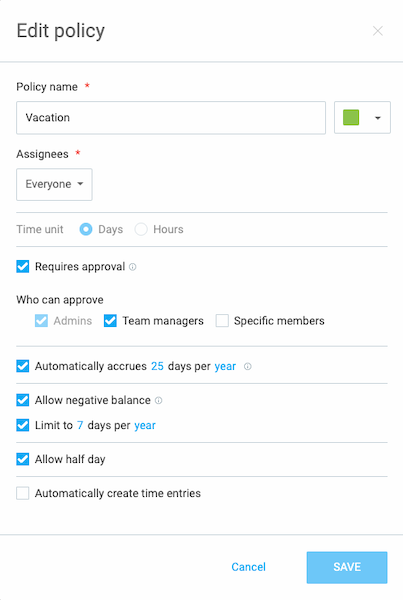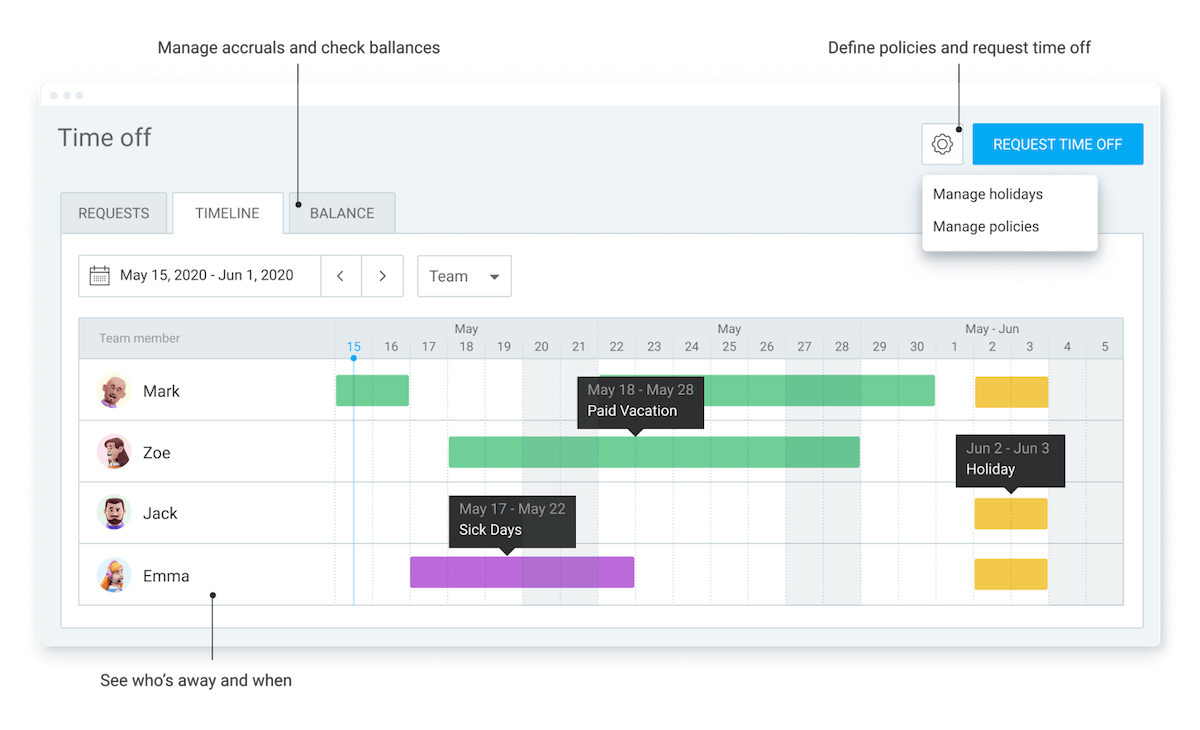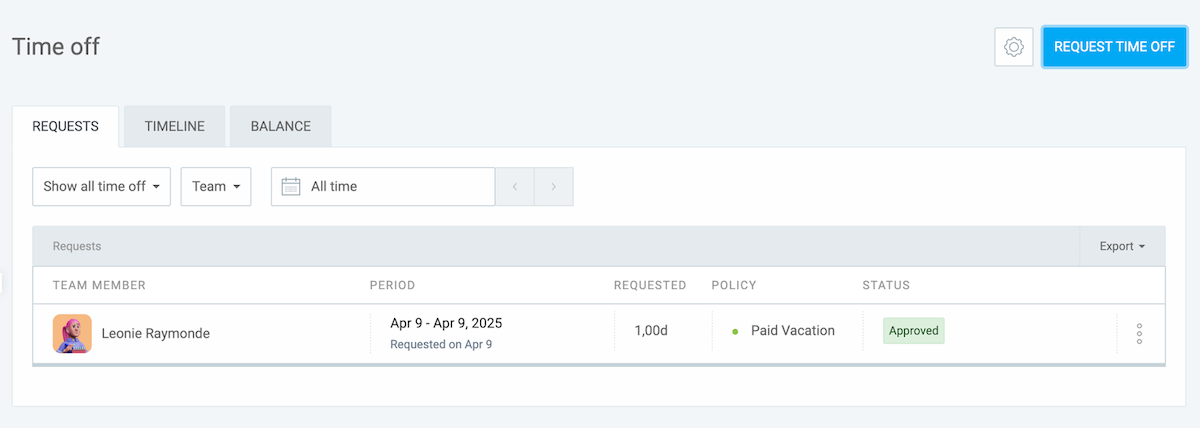Struggling to keep your top performers?
The best employees know their worth and always keep an eye out for better opportunities. And higher salaries aren’t the only reason they leave.
According to insurance industry research, 62% of workers would accept lower pay for better benefits. So, yes — competitive benefits matter more than ever. And if you need a cost-effective perk that won’t break your budget, consider a floating holiday policy.
Let’s see how a floating holiday policy boosts morale and simplifies leave management — and why you need one ASAP.

Table of Contents
What is a floating holiday policy?
A floating holiday policy lets employees choose when to take holiday time off. Instead of getting a fixed day off for a specific date, workers get a floating holiday to use as they see fit.
For example, employees don’t automatically get December 25th off for Christmas. Instead, they receive a floating holiday they can use for Christmas, Hanukkah, Kwanzaa, or any other occasion that matters to them.
💡 CLOCKIFY PRO TIP
Need help crafting a paid holiday policy? Check out our guide on common paid holidays and their benefits:
Why do companies offer floating holidays?
A floating holiday policy is a game changer in workplaces with different cultures and religions.
For instance, Catholics and Orthodox Christians celebrate Easter on different dates, while others may not observe it at all. Respecting such diversity is hard with a fixed holiday policy.
Create holiday policies in Clockify
With floating holidays, employees celebrate based on personal beliefs without complicating leave management. Depending on company rules, workers can also use the day for a birthday or as a regular PTO day.
Many companies offer 1 or 2 floating holidays per year to promote:
- Flexibility — when a business needs to stay open on a major public holiday, its employees receive a day off they can use another time,
- Diversity — when a business wants to build a geographically dispersed team or employs people in a multicultural environment, and
- Work-life balance — when a business wants to reduce burnout among employees and provide more PTO options.
A floating holiday helps companies promote diversity while giving workers more control over their time off.
💡 CLOCKIFY PRO TIP
Want other options for a better work-life balance for your employees? Check out our guide to the pros and cons of an unlimited PTO policy:
What are common floating holiday examples?
Most employees use floating holiday days to celebrate holidays that aren’t observed company-wide or considered public holidays across the country.
In the United States, common examples include:
- Diwali,
- Yom Kippur,
- Eid al-Fitr,
- Eid al-Adha,
- Lunar New Year,
- Good Friday,
- Nowruz, and
- Bodhi Day.
Even though the said holidays aren’t federal holidays in the US, thanks to the floating holiday policies, everyone can feel respected, while employers improve employee morale and retain top talent.
Depending on your company policy, employees may also use their floating holidays for:
- Days before or after traveling,
- Mental health days,
- Various anniversaries,
- Birthdays, and
- Other important family events.
In these cases, employees appreciate getting a paid day off without spending a personal PTO day. In 2025, research by the insurance provider Aflac stated that more than 60% of employees value benefits over salary when comparing job opportunities.
However, to reap the benefits of floating holidays as an employer — you need to implement the policy properly.
💡 CLOCKIFY PRO TIP
Need help introducing an efficient PTO system? Check out our collection of templates for different PTO policies:
How do you implement a floating holiday policy?
Like any other company policy, a floating holiday policy needs to be:
- Clear — ensuring everyone knows when they can take a floating holiday or whether unused days carry over each year,
- Detailed — ensuring every possible use case is covered, and
- Consistent — ensuring the policy treats everyone fairly and equally.
While implementing a floating holiday policy, you must also carefully track and document its use.
Unfortunately, complexity is one of the rare downsides of floating holidays. In other words, managing and approving time off requests becomes difficult with floating holidays, unpaid leave, regular holidays, and personal PTO days.
However, you can simplify leave management with a time tracking tool like Clockify.
Creating a floating holiday policy in Clockify
In Clockify, you can define and manage time off policies for individual employees or the whole team.
To make a floating holiday policy in Clockify, you simply:
- Select the Time off screen from the sidebar,
- Click the Settings icon,
- Press the Create new button,
- Edit your policy, and click Save.

Here, you’ll be able to set each detail of your floating holiday policy, including:
- Eligibility — by assigning the policy to specific employees or teams,
- Time units — days, half-days, or individual hours,
- Accrual methods — accrued automatically per year or month,
- Number of days — by setting a yearly or monthly limit, and
- Approval — whether approval is needed and who can approve time off.
With Clockify, your floating holiday policy has clear rules and a formal approval process.
Create floating holidays in Clockify
You and your staff can view and manage time off balances, employee availability, and leave requests — all in one place via the Time off section.

Employees can request a floating holiday via the blue Request time off button.
You automatically receive a notification, and the request is visible in the Requests tab — where you can quickly approve or deny it.

Before deciding, you can check the team’s availability on the Timeline tab. That way, you’ll always have someone to cover for the employee who takes a floating holiday.
💡 CLOCKIFY PRO TIP
Having trouble with a surge of leave requests during the holiday season? Check out our guide to managing and tracking PTO requests:
Floating holiday vs PTO — What’s the difference?
PTO and floating holidays are both paid days off. However, they serve different purposes. Depending on your company policies, they may also follow different rules.
The following table will help you understand the difference between PTO and floating holidays.
| Type of paid leave | PTO | Floating holiday |
| Purpose | General use (vacation time, personal time off, and sometimes sick days). | Celebrating a holiday or a personal milestone that’s not observed company-wide. |
| Accrual policy | Typically accrued over time. | Typically offered as a fixed number of days each year. |
| Use-it-or-lose it policy | Depending on company policy and state law, unused days may be carried over into the next year. | Usually expires at the end of the calendar year. |
| Payout upon termination | Depending on company policy and state law, unused days are sometimes paid out upon termination. | Typically not paid out when employees leave the company. |
💡 CLOCKIFY PRO TIP
Want to learn more about other types of paid leave? Check out our guide to the differences between general PTO and vacation:
FAQ about floating holidays
Now that you’re familiar with the details of floating holiday policies, we’ll answer some of the most frequently asked questions about the topic.
Do you get paid for floating holidays?
In most cases, yes. The majority of companies offer floating holidays as paid days off. However, some employers might only provide unpaid holiday leave. Consult your company policies and state laws for more information.
Do floating holidays expire?
Yes. In most cases, company policies state that unused floating holidays expire at the end of the calendar year. However, specific policies vary from employer to employer, so check your employment agreement and relevant laws.
How many floating holidays do companies offer?
Most employers offer 1–2 floating holidays per year. Again, this depends on the specifics of your company’s employment agreements.
Can floating holidays be used during blackout dates?
Not usually. A company designates blackout dates (specific calendar dates when employees can’t take time off) to ensure workers are present when absolutely necessary. Usually, these are periods when there’s a lot of work.
Are floating holidays mandatory for employers to provide?
No. Floating holidays aren’t mandated by federal law, but many companies still offer them as part of an enticing benefits package. While state laws might differ, no states mandate floating holidays at the moment.
Manage floating holiday policies with Clockify
With our reliable and powerful tool, Clockify, creating an effective floating holiday policy is quick and straightforward. You can also use our time tracker to:
- Schedule tasks easily in a visual drag-and-drop interface,
- Export detailed reports for payroll or share them with clients, and
- Sync with QuickBooks and similar tools for simpler accounting.
Clockify simplifies time off management and eliminates the need for disorganized notes and spreadsheets — which also means fewer manual errors.
If you need help setting up a time off policy or anything else, Clockify also provides 24/7 support to all users free of charge, regardless of their plan — with an average response rate of just 1 hour.


